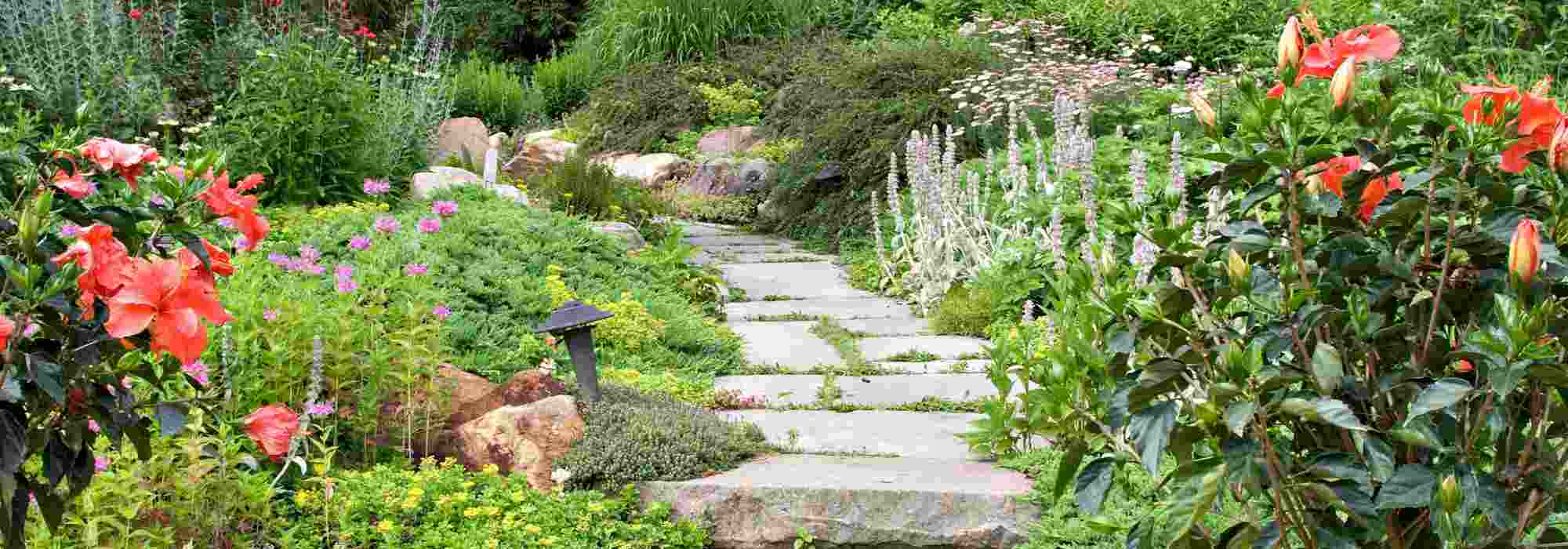
Which plants to border a path?
Choosing the right border plants for a garden path
Contents
Paths and walkways are high-traffic areas, which you see every day. So it’s worth landscaping them with care and giving them character! Choose mainly evergreen plants by playing with textures, flowering periods, foliage colours… to create a lovely atmosphere all year round. Also favour sturdy, resilient plants that can withstand being brushed against, occasionally being lightly trodden on or that don’t flop into the path. Likewise, plants should not exceed 90 cm or even 1 m in height. Finally, we recommend avoiding thorny or overly invasive plants as they can cause nuisance, obstruct passage or require too frequent maintenance. Suited to your climate, soil and sun exposure, plants are then chosen according to the style of your garden. Wild, English-style, classic, Japanese or Mediterranean… each garden style has its ideal border plants. Discover our tips to choose the right border plants for your path.
For a classic garden
In classical gardens such as French or Italian ones, paths are bordered in a linear fashion by plants with geometric forms (topiaries) that are definite and remain identical whatever the season. A single evergreen species is chosen and pruned in a homogeneous, low manner to border the path on both sides. For this, plants that tolerate pruning should be favoured. Whether spherical, pyramidal or as a small low hedge, all geometric forms are represented.
Boxwood is undoubtedly indispensable in this garden style but today, given diseases affecting it, we favour other bushes that are just as beautiful, evergreen and tolerant of pruning such as shrubby honeysuckle (Lonicera nitida), Ebbinge’s oleaster (Eleagnus ebbingei), crenate holly, yews or evergreen spindles (Euonymus fortunei). In addition, these allow more varied and consistent colours throughout the year thanks to their golden foliage such as that of Euonymus fortunei ‘Emerald ‘n Gold’.
For a taller path border, hornbeam can be used. Easy to shape and to prune, it also remains attractive in winter. Its leaves take a lovely amber colour then dry in autumn and remain in place for a long time, until new leaves appear (phenomenon of marcescence). It is also possible to create hornbeam balls.

Classical avenues at Manoir de la Groye and gardens of Château du Pin, Maine-et-Loire (Photos: Gwenaëlle David)
Read also
7 shrubs to line a pathFor an English garden
Borders along garden paths in English gardens reflect mixed-borders: flowering, colourful, varied, informal and changing with seasons. These borders follow curves and movements of garden paths.
Characterful borders still require harmony among plants. To achieve this, use same species in different colours or limit number of species to four or five by choosing complementary colours or tonal ranges (same hue). Species to favour have compact forms or abundant flowering to create a border that is both natural and controlled. For this, we recommend mixing staggered, year-round flowering with decorative foliage:
- spring flowering: campanulas, aubrietas, columbines, creeping bugles, nepetas, phlox, and of course dwarf bushes (Abelia, Daphne…)
- summer flowering: dwarf roses, daylilies and agapanthus
- autumn flowering: dwarf asters and heathers
- winter flowering: heathers, Christmas roses, Sarcococca
- foliage of heucheras, alchemillas, carex, hostas, Leucothoe, Nandina or Pittosporum
And of course, don’t forget fabulous collection of hardy geraniums offering long flowering, good hardiness and minimal maintenance. English garden wouldn’t be English without some borders planted with hardy geraniums!
For colourful, striking effect, scatter splashes of iris, daffodil or tulip bulbs. Guaranteed!
In an English garden, consider occasional tall planted borders that create suspense and invite strolls. For this, hydrangeas are choice bushes for showcasing blooms in a range of colours. Discover our full range of hydrangeas.
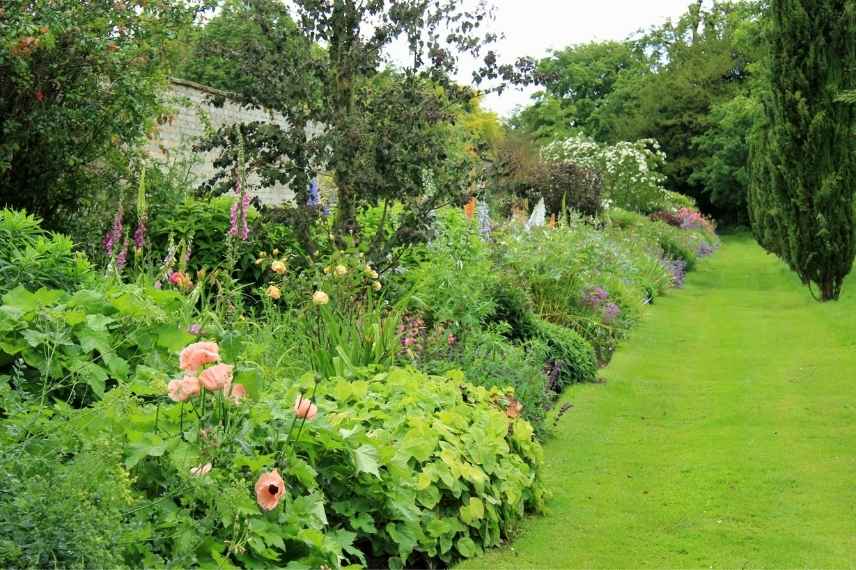
English-style mixed-borders charmingly line large paths (Photo : K. Roe)
For a Mediterranean garden
Garden path borders in Mediterranean gardens are perhaps the easiest to imagine thanks to the many aromatic plants that fit perfectly. They are chosen to create flowing, evergreen borders. No one can deny the charm of a path lined with lavender. Magical scent, aesthetic appeal, blue flowers and easy maintenance are the watchwords.
Other aromatic plants work wonders, such as santolina’s green cushions, the tapetum of pink flowers of thymes and the grey of foliage of curry herb. As you pass, simply pick a few leaves for your meal. Also consider the beautiful salvias that flower for a long time such as Salvia microphylla or Salvia greggi and dancing grasses such as Stipa.
We can also imagine soft-to-touch plants along the way, such as lamb’s ear or Pelargonium tomentosum.
In rockeries, opt for bergenias, fleabanes, blue fescues or sedums. Finally, narrow-leaved rockrose also works wonders with its white spring flowers.
→ Read Ingrid’s advice: How to plant lavender as a border to structure your beds.
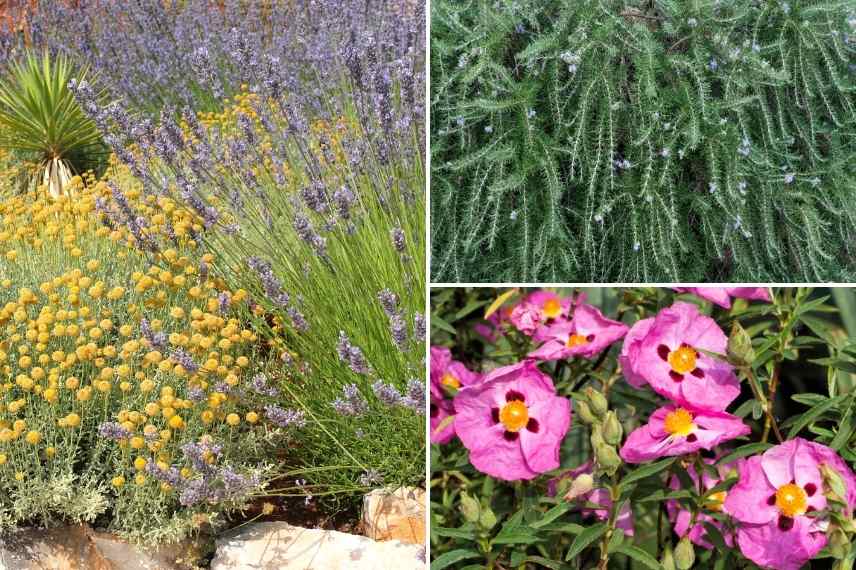
Lavender, Helicrysum, rosemary and rockrose immediately evoke Mediterranean atmosphere
For a Japanese garden
From changing foliage colours to spectacular cherry flowering, observation of seasons is a major characteristic of Japanese garden. Border plants must also follow this rule. For this, small evergreen rhododendrons and azaleas work wonders thanks to spring flowering in white, pink, purple, orange or even blue. They form small flowering cushions that will brighten with their flamboyant colours. Also consider Pieris, Skimmia, small Camellias and dwarf conifers. Group several plants to create a colourful mass effect. However, respect cultural requirements of these plants: they prefer acidic soil.
In Japanese gardens, other border plants are essential: dark foliage of black Ophiopogon, verdant tapetum of helxine, dwarf bamboos and evergreen ferns such as false capillary and hart’s-tongue fern. We recommend alternating patches of each species to create dynamism in shapes and colours.
As for dwarf bamboos, use them to form charming low hedges under one metre high. Look to Pleioblastus (better to give an example). Easy to maintain and to prune, but their running rootstock require a root barrier to prevent spread into your path or garden.

A Japanese-style pathway at Jardin du Petit Bordeaux (Sarthe) (Photo: G. David); Rhododendrons and Ophiopogons contribute to oriental ambience
For a naturalistic or wild garden
In a wild garden, border plants are varied in colour and species. There is no monotony in borders of wild gardens. Dynamism, fluidity and heterogeneity are reflected in borders of its paths. Here, annual or deciduous plants may even be envisaged, appearing and disappearing with the seasons and over the years. For this, a wide choice of species is available to you :
- Flowering groundcover : the fleabanes with white flowering reminiscent of daisies, the nepetas with purple flowering, garden cornflowers or nasturtiums with orange flowers.
- Decorative foliage of carex and hairgrass.
- Taller plants that bring dynamism : flowering ones such as gaura or Russian sage ‘Little Spire’, and grasses with flowing foliage such as miscanthus (some varieties such as ‘Adagio’, ‘Gnom’, ‘Little Zebra’ do not exceed 1 m in height).
The border is planted with a great diversity of species. Each species is planted alone or in a small reduced group. Disorder, fluidity and spontaneity should breathe in these wild borders. Give free rein to your creativity!
To finish in style, consider matching your border plants to materials used for your path or edging. For example, a red-brick path pairs wonderfully with plants in warm colours while a white gravel path suits foliage and flowers in shades of blue and violet.
To complete your inspiration notebook, consult our article 10 bushes to edge a path (web link to be added).
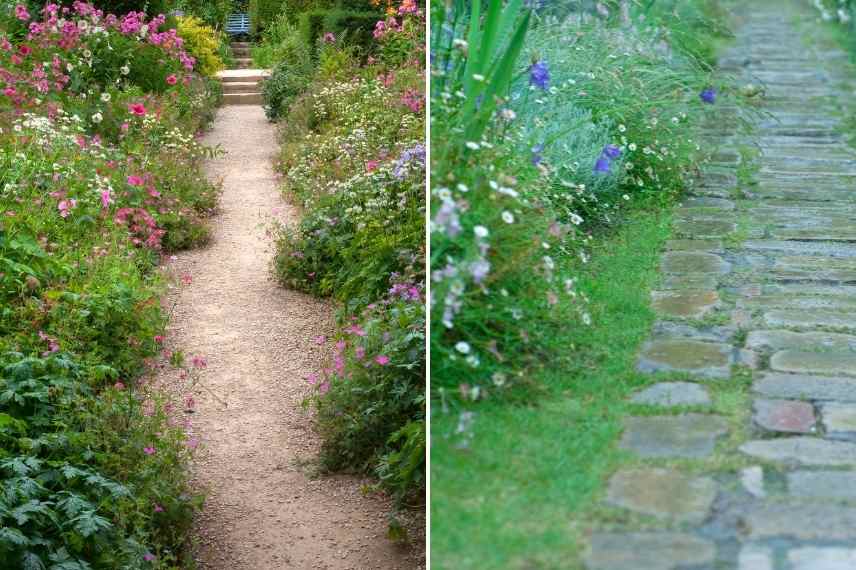
In a natural garden, favour plants with a flexible habit, mixing heights
For an exotic garden
Exotic gardens are defined by luxuriance and richly coloured flowers. Their borders are no exception. For foliage, opt for flowing tufted foliage of Japanese herb or ophiopogon. To create a tapetum of fine, graphic leaves, Muehlenbeckia axillaris is ideal, whereas ferns such as the Dryopteris cycadina and Polystichum setiferum provide greater height.
You can also choose species that combine lush foliage and abundant flowering such as agapanthus, hostas, Virginia bluebells or false orchids. For agapanthus, we recommend evergreen species like Agapanthus ‘Blue Heaven’ with striking blue flowering or Agapanthus ‘Back in Black’ with umbels of dark blue‑black flowers. As for hostas, we recommend the variegated foliage of Hosta ‘Green Gold’ or Hosta undulata var albomarginata. Finally, Roscoea purpurea ‘Cinnamon Stick’ is a false orchid that will perform wonderfully with its purple flowering streaked with white.
To perfect your paths in style, consider matching your border plants to the materials used for your path or hard edging. For example, a red‑brick path pairs beautifully with plants in warm colours, while a white gravel path complements foliage and flowers in shades of blue and violet.
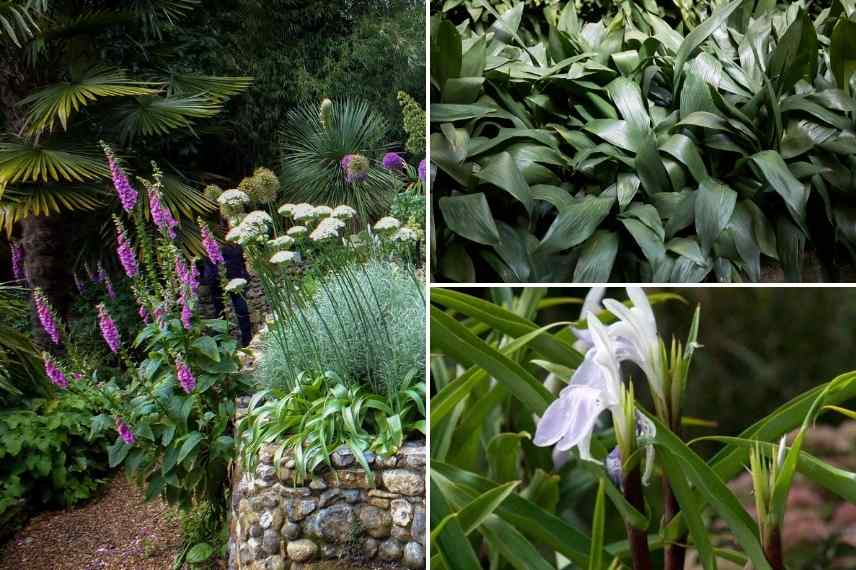
A path with exotic accents on the left, Aspidistra ‘Eliator‘ and Roscoea purpurea ‘Cinnamon Stick’
- Subscribe!
- Contents
![[plant_list category="border_plants"]](https://www.promessedefleurs.ie/blogwp/wp-content/uploads/2021/01/Quelles-plantes-pour-border-une-allee.jpg)































Comments